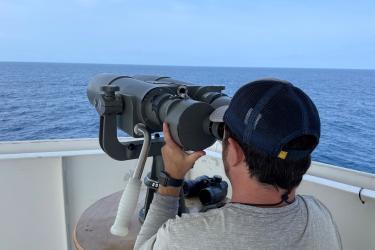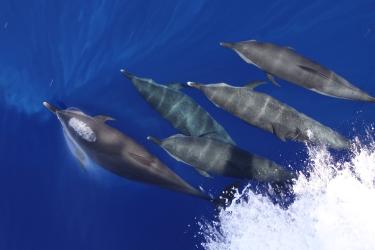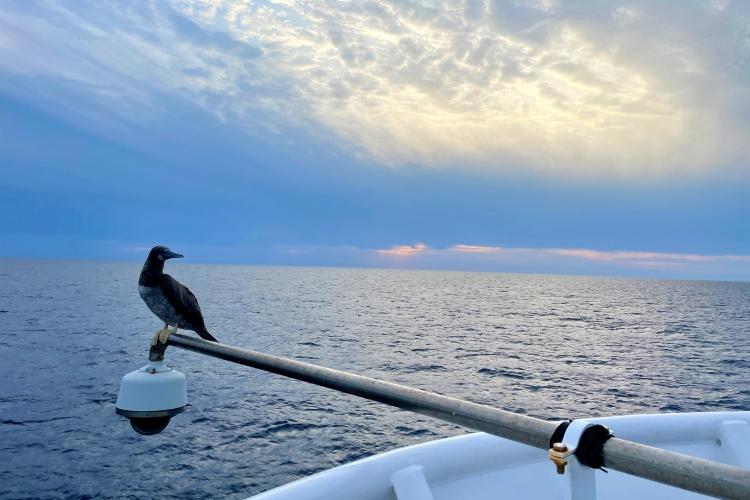A survey to update information on abundance and distribution to restore marine mammal and seabird populations in the Gulf of Mexico.
A group of scientists recently departed from Pascagoula, Mississippi aboard the NOAA ship Gordon Gunter to collect data to help inform plans to restore marine mammal and seabird populations. The 2-month long vessel survey will be conducted in three legs between June 22nd and August 17th. It will survey more than 3,400 miles of trackline covering the deep waters of the northern Gulf of Mexico.
During the 2010 Deepwater Horizon oil spill, marine mammals and seabirds died and experienced negative health effects from exposure to oil. While restoration efforts are underway, there is limited data to inform planning, implementation, and evaluation of restoration for marine mammals and seabirds. The Vessels Surveys For Abundance and Distribution of Marine Mammals and Seabirds project (PDF, 20 Pages) will address these critical data gaps.
 Scientist Jesse Wicker observes through the big eyes in the Northern Gulf of Mexico. (Image credit: NOAA Fisheries/Ellie Hartman)
Scientist Jesse Wicker observes through the big eyes in the Northern Gulf of Mexico. (Image credit: NOAA Fisheries/Ellie Hartman)
This survey will employ the same methods used 5 years ago during the Gulf of Mexico Marine Assessment Program for Protected Species study. The ship will survey along predetermined tracklines, and two observer teams will conduct visual surveys for marine mammals and seabirds. The marine mammal observers will spend most of their time looking through “big eyes” (giant binoculars) searching for animals. Once they spot a marine mammal, they will identify the species, determine the group size, and take photos. The seabird observers will perform similar tasks using handheld binoculars. There will also be an acoustic team listening for and recording marine mammal vocalizations using a towed array of hydrophones to help add to the data collected by the visual observers.
The Gulf of Mexico Marine Assessment Program for Protected Species study estimated the abundance of marine mammals. It used statistical models to create maps showing the spatial distribution of marine mammals and their habitats. Within the past 10 years, the study also identified possible decreases in the abundance of some oceanic dolphins and changes in the spatial distribution of sperm whales. The mission of this new survey is to determine if these declining trends are continuing. It will gather additional data on both the distribution (where) and abundance (how many) of marine mammals and seabirds. These data will be used to update habitat models and will provide insights into how abundance and distribution may change over time in response to changes in the environment.
 Pantropical spotted dolphins riding the bow of the boat. (Image credit: NOAA Fisheries/Laura Dias [Permit # 14450])
Pantropical spotted dolphins riding the bow of the boat. (Image credit: NOAA Fisheries/Laura Dias [Permit # 14450])
These data and updated models will inform long term conservation and management of marine mammal and seabird populations in the Gulf. This will improve the information available to natural resource managers as they try to limit the risks to marine mammal and seabird populations from activities such as aquaculture and wind energy development. The study will help improve restoration planning to make sure that projects are designed to provide the maximum benefits to the species injured during the Deepwater Horizon oil spill.
This survey is a joint effort between the US Fish and Wildlife Service and NOAA’s Southeast Fisheries Science Center.
We will be providing frequent updates throughout the survey over the next 2 months, so be on the lookout for our upcoming posts!
 A brown booby enjoyed the ride on the bow of the NOAA Ship Gordon Gunter in the northern Gulf of Mexico. (Image credit: NOAA Fisheries)
A brown booby enjoyed the ride on the bow of the NOAA Ship Gordon Gunter in the northern Gulf of Mexico. (Image credit: NOAA Fisheries)


![Pilot whales surface near the NOAA Ship Gordon Gunter. (Image credit: NOAA Fisheries/Melody Baran [Permit # 14450])](/images/Newsletter/0_2023/Week-06-26-23/SurveyCollecting.jpg)
